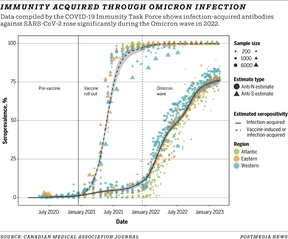Infection
Omicron led to 76 per cent of Canadians being infected with COVID-19: study
“The fact that antibodies wane after about six months and the fact that this virus is always mutating means that although we lived through the public health emergency, we’re not out of the woods.”
Article content
In the year after COVID-19 first hit Canada, fewer than one in 100 people were infected with the disease. Even after 20 months, only nine per cent of Canadians had contracted COVID-19 by November 2021.
That would all change with Omicron. Half a year after the new, highly contagious variant of the SARS-CoV-2 virus first started cropping up in December 2021, nearly half the population would become infected, despite the fact most Canadians were fully vaccinated. By March 2023, after 16 months dominated by the variant, 76 per cent of Canadians had developed immunity due to an infection. Rates were even higher among younger segments of the population.
Advertisement 2
Story continues below
Article content
Article content
The findings on infection-fuelled immunity — as opposed to vaccine protection — were published Monday in the Canadian Medical Association Journal (CMAJ), based on a study carried out by the COVID-19 Immunity Task Force (CITF), with the help of a Canada-wide team of collaborating scientists.
“Despite high vaccine coverage in Canada, the rate of infection rose rapidly with the highly contagious Omicron variant,” said Bruce Mazer, study co-lead and senior scientist at the research institute of the McGill University Health Centre. “After six months with the Omicron variant circulating in Canada, in mid-June 2022, infection-acquired seroprevalence had risen to 47 per cent, with an average monthly increase of 6.4 per cent.”

The results were collected via data looking at 900,000 samples primarily derived from blood donors, as well as estimates from provincial laboratory studies that tested residual blood samples from people of all ages.
Omicron combined with looser restrictions sparked the latest wave, especially among younger people.
“During Omicron, rates of infection-acquired immunity increased faster in younger age groups and in the western provinces of Manitoba, Saskatchewan, Alberta and British Columbia,” said study co-lead David Buckeridge, a professor of global health at McGill.
Article content
Advertisement 3
Story continues below
Article content
“By March 2023, roughly 80 per cent of adults aged 18-25 had evidence of a previous infection. That’s compared to approximately 75 per cent of those aged 25-39 years, 70 per cent of those aged 40-59 years, and 60 per cent of those 60 and over.”
Canadians were fortunate that despite the rapid spread of infection there weren’t more severe illnesses or deaths, thanks to high rates of vaccination, Buckeridge said.
Quebec and other provinces in Canada are planning to roll out a new vaccine campaign in the fall, with vaccines tailored to more recent variants of Omicron. Numbers of COVID-19 infections in Quebec have been rising slowly in recent weeks, in part due to the arrival of a new, highly transmissible variant dubbed Eris, but the number of severe illnesses and fatalities has stayed relatively low.
Despite the immunity granted from high levels of infections and vaccinations, “the fact that antibodies wane after about six months and the fact that this virus is always mutating means that although we lived through the public health emergency, we’re not out of the woods,” Buckeridge said in an interview. “People will need to keep their eyes on it, unfortunately, and need to listen to what advice they get from their family doctors and also the provincial authorities around vaccination.”
Advertisement 4
Story continues below
Article content
The CITF, which is funded by the Public Health Agency of Canada, has supported 120 research studies focused on immunity to SARS-CoV-2, often among under-represented populations and those living in long-term care.
“The study showed us that there is a lot of variation in how the population was infected, and how they responded to infections, as well as vaccinations,” Buckeridge said. “Going forward, we need to monitor that and to use the information to allow people to make better decisions, but also on how to make better policy decisions on when we should be promoting other types of vaccine studies or actions that might be more beneficial to the population.”
-

As a new variant takes hold, what’s the COVID-19 situation in Quebec?
-

Get another COVID-19 booster in the fall, Canada’s immunization panel recommends




Comments
Postmedia is committed to maintaining a lively but civil forum for discussion and encourage all readers to share their views on our articles. Comments may take up to an hour for moderation before appearing on the site. We ask you to keep your comments relevant and respectful. We have enabled email notifications—you will now receive an email if you receive a reply to your comment, there is an update to a comment thread you follow or if a user you follow comments. Visit our Community Guidelines for more information and details on how to adjust your email settings.
Join the Conversation